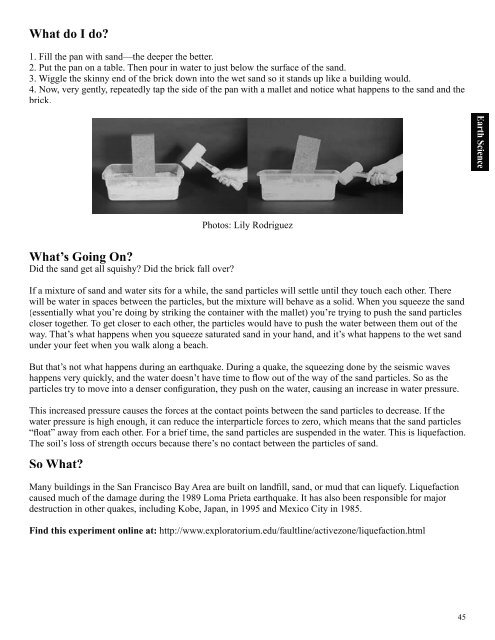ScienceMakers Toolkit Manual - The History Makers
ScienceMakers Toolkit Manual - The History Makers
ScienceMakers Toolkit Manual - The History Makers
Create successful ePaper yourself
Turn your PDF publications into a flip-book with our unique Google optimized e-Paper software.
What do I do?<br />
1. Fill the pan with sand—the deeper the better.<br />
2. Put the pan on a table. <strong>The</strong>n pour in water to just below the surface of the sand.<br />
3. Wiggle the skinny end of the brick down into the wet sand so it stands up like a building would.<br />
4. Now, very gently, repeatedly tap the side of the pan with a mallet and notice what happens to the sand and the<br />
brick.<br />
What’s Going On?<br />
Did the sand get all squishy? Did the brick fall over?<br />
Photos: Lily Rodriguez<br />
If a mixture of sand and water sits for a while, the sand particles will settle until they touch each other. <strong>The</strong>re<br />
will be water in spaces between the particles, but the mixture will behave as a solid. When you squeeze the sand<br />
(essentially what you’re doing by striking the container with the mallet) you’re trying to push the sand particles<br />
closer together. To get closer to each other, the particles would have to push the water between them out of the<br />
way. That’s what happens when you squeeze saturated sand in your hand, and it’s what happens to the wet sand<br />
under your feet when you walk along a beach.<br />
But that’s not what happens during an earthquake. During a quake, the squeezing done by the seismic waves<br />
happens very quickly, and the water doesn’t have time to fl ow out of the way of the sand particles. So as the<br />
particles try to move into a denser confi guration, they push on the water, causing an increase in water pressure.<br />
This increased pressure causes the forces at the contact points between the sand particles to decrease. If the<br />
water pressure is high enough, it can reduce the interparticle forces to zero, which means that the sand particles<br />
“fl oat” away from each other. For a brief time, the sand particles are suspended in the water. This is liquefaction.<br />
<strong>The</strong> soil’s loss of strength occurs because there’s no contact between the particles of sand.<br />
So What?<br />
Many buildings in the San Francisco Bay Area are built on landfi ll, sand, or mud that can liquefy. Liquefaction<br />
caused much of the damage during the 1989 Loma Prieta earthquake. It has also been responsible for major<br />
destruction in other quakes, including Kobe, Japan, in 1995 and Mexico City in 1985.<br />
Find this experiment online at: http://www.exploratorium.edu/faultline/activezone/liquefaction.html<br />
45<br />
Earth Science










